Theoretical and Experimental Research on an Optimal Control for a Magnetorheological Shock Mitigation System
Abstract
:1. Introduction
2. Damping Force Characteristics of MREA under Impact Load
2.1. Design and Manufacture an MREA
2.2. Magnetic Field Simulation of the MREA
2.3. Damping Force Model of the MREA
- (1)
- Entrance effect for flow from region A1 to A2;
- (2)
- Exit effect for flow from region A2 to A3.
2.4. Experimental Setup for Damping Force
3. The Algorithm Design of Optimal Generalized Bingham Number Control
4. Comparison of Control Effect between BN Control and GBN Control
4.1. Simulation Results
4.2. Experimental Results
5. Conclusions
- The GBN control can achieve a soft landing accurately.
- The damping force of an MREA is proportional to the square of piston velocity at high sink rate.
- The quadratic GBN control strategy is superior to the linear BN control strategy in terms of soft-landing control accuracy. Limited by the accuracy of the damping force model, the BN control caused either an end-stop impact or incomplete exploitation of the available stroke.
Author Contributions
Funding
Institutional Review Board Statement
Informed Consent Statement
Data Availability Statement
Conflicts of Interest
References
- Roshan, F.; Dashtimanesh, A.; Kujala, P. Safety Improvements for High-Speed Planing Craft Occupants: A Systematic Review. J. Mar. Sci. Eng. 2024, 12, 845. [Google Scholar] [CrossRef]
- Hughes, K.; Campbell, J.; Vignjevic, R. Application of the finite element method to predict the crashworthy response of a metallic helicopter under floor structure onto water. Int. J. Impact Eng. 2008, 35, 347–362. [Google Scholar] [CrossRef]
- Ghimire, A.; Hsu, C.H.; Lin, C.C.; Chen, P.Y. Hierarchical nested honeycomb-based energy absorbers: Design factors and tailorable mechanical properties. Interface Focus 2024, 14, 20230066. [Google Scholar] [CrossRef]
- Reid, S.R. Plastic deformation mechanisms in axially compressed metal tubes used as impact energy absorbers. Int. J. Mech. Sci. 1993, 35, 1035–1052. [Google Scholar] [CrossRef]
- Zhou, G.; Hill, M.D. Impact damage and energy-absorbing characteristics and residual in-plane compressive strength of honeycomb sandwich panels. J. Sandw. Struct. Mater. 2009, 11, 329–356. [Google Scholar] [CrossRef]
- Xu, P.; Zhao, H.; Yao, S.; Che, Q.; Xing, J.; Huang, Q.; Xu, K. Multi-objective optimisation of a honeycomb-filled composite energy absorber for subway vehicles. Int. J. Crashworthiness 2019, 25, 603–611. [Google Scholar] [CrossRef]
- Rakheja, S.; Afework, Y.; Sankar, S. An Analytical and Experimental Investigation of the Driver Seat Suspension. Syst. Veh. Syst. Dyn. 1994, 23, 501–524. [Google Scholar] [CrossRef]
- Jackson, K.E.; Fasanella, E.L.; Boitnott, R.; McEntire, J.; Lewis, A. Occupant Responses in a Full-Scale Crash Test of the Sikorsky ACAP Helicopter. J. Am. Helicopter Soc. 2004, 49, 127–139. [Google Scholar] [CrossRef]
- Dyke, S.J.; Spencer, B.F.; Sain, M.K.; Carlson, J.D. Modeling and control of magnetorheological dampers for seismic response reduction. Smart Mater. Struct. 1996, 5, 565–575. [Google Scholar] [CrossRef]
- Wang, M.; Chen, Z.; Wereley, N.M. Magnetorheological damper design to improve vibration mitigation under a volume constraint. Smart Mater. Struct. 2019, 28, 114003. [Google Scholar] [CrossRef]
- Kong, G.; Ouyang, Q.; Hu, H.; Xiang, W.; Zhao, W. Structural Design and Controllability of Magnetorheological Grease Buffers under Impact Loading. Materials 2023, 16, 4724. [Google Scholar] [CrossRef]
- Shou, M.; Liao, C.; Yang, P.-A.; Huang, X.; Wu, D.; Zhou, Z.; Luo, J.; Li, R. Hybrid modeling of the nonlinear behaviors for magnetorheological energy absorber. Hybrid modeling of the nonlinear behaviors for magnetorheological energy absorber. Int. J. Mech. Sci. 2023, 243, 107820. [Google Scholar] [CrossRef]
- Ouyang, Q.; Zheng, J.; Li, Z.; Hu, M.; Wang, J. Controllability analysis and testing of a novel magnetorheological absorber for field gun recoil mitigation. Smart Mater. Struct. 2016, 25, 115041. [Google Scholar] [CrossRef]
- Singh, H.J.; Wereley, N.M. Optimal control of gun recoil in direct fire using magnetorheological absorbers. Smart Mater. Struct. 2014, 23, 055009. [Google Scholar] [CrossRef]
- Choi, Y.T.; Robinson, R.; Hu, W.; Wereley, N.M.; Birchette, T.S.; Bolukbasi, A.O.; Woodhouse, J. Analysis and control of a magnetorheological landing gear system for a helicopter. J. Am. Helicopter Soc. 2016, 61, 1–8. [Google Scholar] [CrossRef]
- Ahuré-Powell, L.A.; Choi, Y.T.; Hu, W.; Wereley, N.M. Nonlinear Modeling of Adaptive Magnetorheological Landing Gear Dampers under Impact Conditions. Smart Mater. Struct. 2016, 25, 115011. [Google Scholar] [CrossRef]
- Saleh, M.; Sedaghati, R.; Bhat, R. Dynamic analysis of an SDOF helicopter model featuring skid landing gear and an MR damper by considering the rotor lift factor and a Bingham number. Smart Mater. Struct. 2018, 27, 065013. [Google Scholar] [CrossRef]
- Kang, B.K.; Choi, S.B. Design, structure analysis and shock control of aircraft landing gear system with MR damper. Smart Mater. Struct. 2024, 33, 055049. [Google Scholar] [CrossRef]
- Han, C.; Kang, B.-H.; Choi, S.-B.; Tak, J.M.; Hwang, J.-H. Control of landing efficiency of an aircraft landing gear system with magnetorheological dampers. J. Aircr. 2019, 56, 1980–1986. [Google Scholar] [CrossRef]
- Luong, Q.V.; Jang, D.S.; Hwang, J.H. Robust adaptive control for an aircraft landing gear equipped with a magnetorheological damper. Appl. Sci. 2020, 10, 1459. [Google Scholar] [CrossRef]
- Luong, Q.V.; Jang, D.S.; Hwang, J.H. Intelligent Control based on a neural network for aircraft landing gear with a magnetorheological damper in different landing scenarios. Appl. Sci. 2020, 10, 5962. [Google Scholar] [CrossRef]
- Luong, Q.V.; Jo, B.H.; Hwang, J.H.; Jang, D.-S. A Supervised Neural Network Control for Magnetorheological Damper in an Aircraft Landing Gear. Appl. Sci. 2021, 12, 400. [Google Scholar] [CrossRef]
- Wang, C.; Nie, H.; Chen, J.; Lee, H.P. The design and dynamic analysis of a lunar lander with semi-active control. Acta Astronaut. 2019, 157, 145–156. [Google Scholar] [CrossRef]
- Wang, C.; Chen, J.; Li, X.; Chen, H.; Nie, H.; Lin, F. Design, dynamic analysis, and experiments of MRF dampers for lunar landers. Adv. Space Res. 2021, 68, 3012–3025. [Google Scholar] [CrossRef]
- Bai, X.X.; Yang, S. Hybrid controller of magnetorheological semi-active seat suspension system for both shock and vibration mitigation. J. Intell. Mater. Syst. Struct. 2019, 30, 1613–1628. [Google Scholar] [CrossRef]
- Wereley, N.M.; Choi, Y.-T.; Singh, H.J. Adaptive energy absorbers for drop-induced shock mitigation. J. Intell. Mater. Syst. Struct. 2011, 22, 515–519. [Google Scholar] [CrossRef]
- Choi, Y.-T.; Wereley, N.M. Drop-induced shock mitigation using adaptive magnetorheological energy absorber incorporating a time lag. ASME J. Vib. Acoust. 2015, 137, 01101. [Google Scholar] [CrossRef]
- Wang, M.; Chen, Z.; Wereley, N.M. Adaptive magnetorheological energy absorber control method for drop-induced shock mitigation. J. Intell. Mater. Syst. Struct. 2021, 32, 449–461. [Google Scholar] [CrossRef]
- Saleh, M.; Sedaghati, R.; Bhat, R. Design optimization of a bi-fold MR energy absorber subjected to impact loading for skid landing gear applications. Smart Mater. Struct. 2019, 28, 035031. [Google Scholar] [CrossRef]
- Mao, M.; Hu, W.; Choi, Y.-T.; Wereley, N.; Browne, A.L.; Ulicny, J. Experimental validation of a magnetorheological energy absorber design analysis. J. Intell. Mater. Syst. Struct. 2014, 25, 352–363. [Google Scholar] [CrossRef]
- Bai, X.X.; Hu, W.; Wereley, N.M. Magnetorheological damper utilizing an inner bypass for ground vehicle suspensions. IEEE Trans. Magn. 2013, 49, 3422–3425. [Google Scholar] [CrossRef]
- Wang, M.; Chen, Z.; Yan, H.; Choi, Y.-T.; Wereley, N.M. Optimal control of drop-induced shock mitigation using magnetorheological energy absorbers considering quadratic damping. J. Intell. Mater. Syst. Struct. 2021, 32, 1504–1517. [Google Scholar] [CrossRef]
- Singh, H.J.; Hu, W.; Wereley, N.M.; Glass, W. Experimental validation of a magnetorheological energy absorber design optimized for shock and impact loads. Smart Mater. Struct. 2014, 23, 125033. [Google Scholar] [CrossRef]



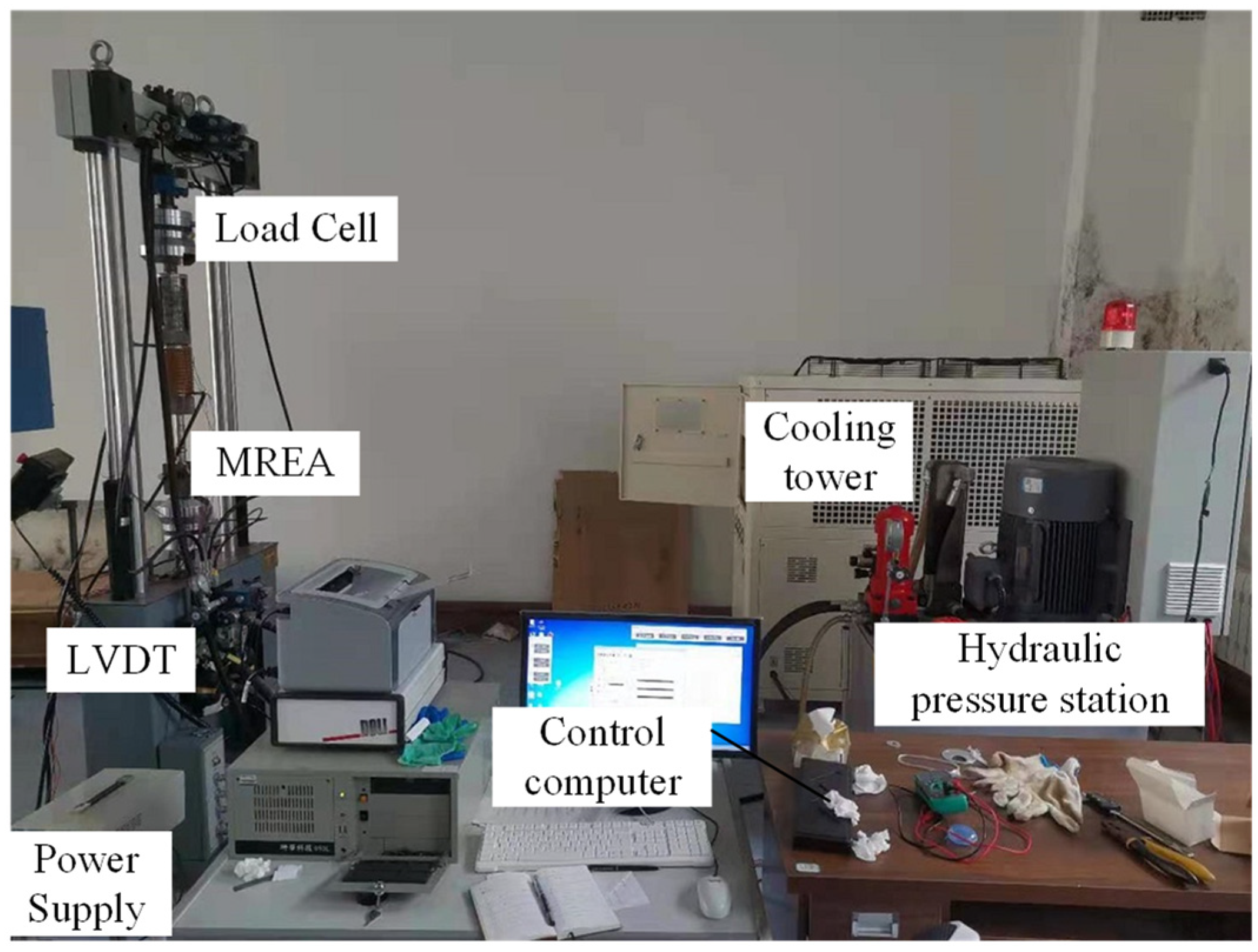

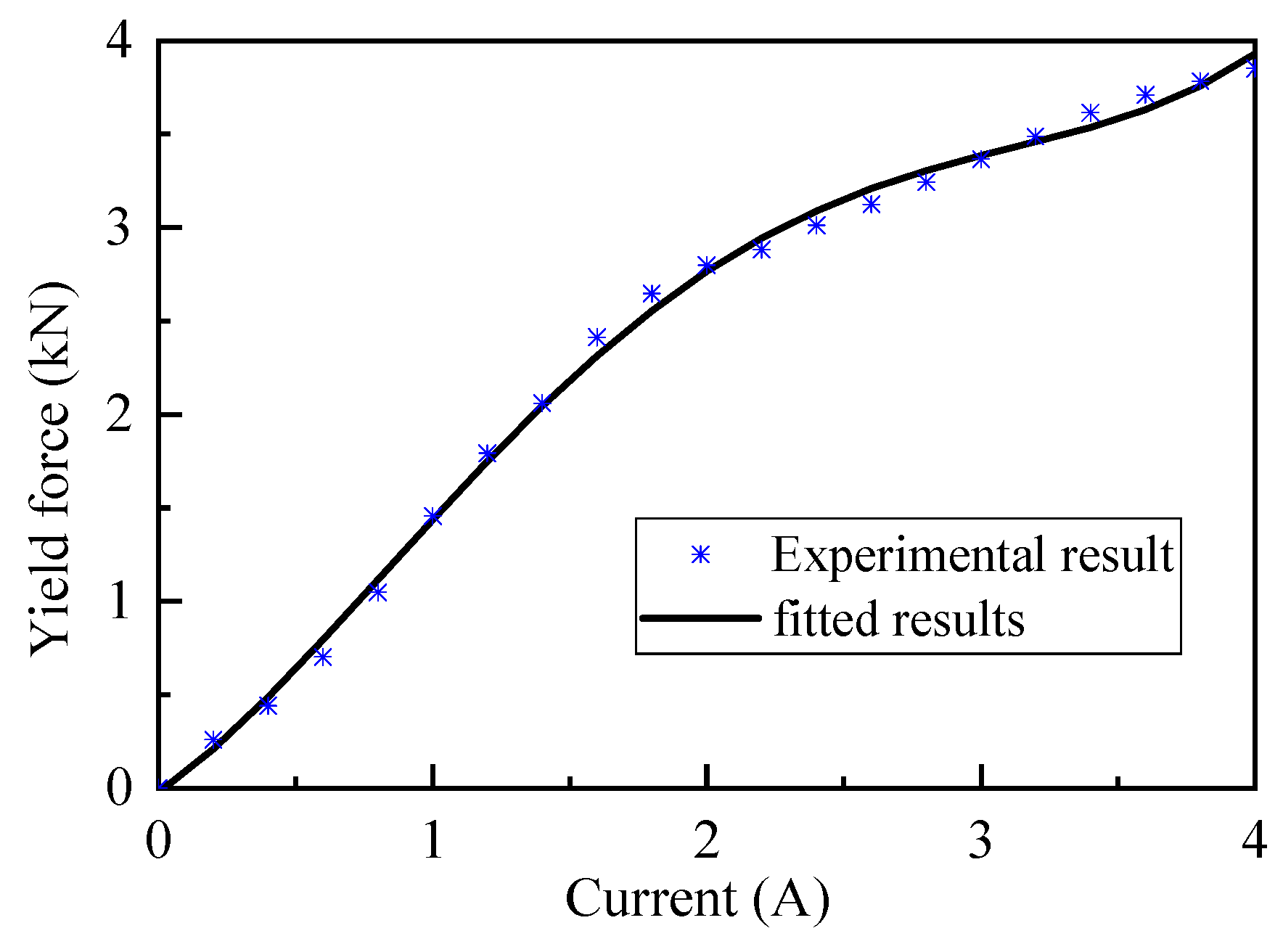
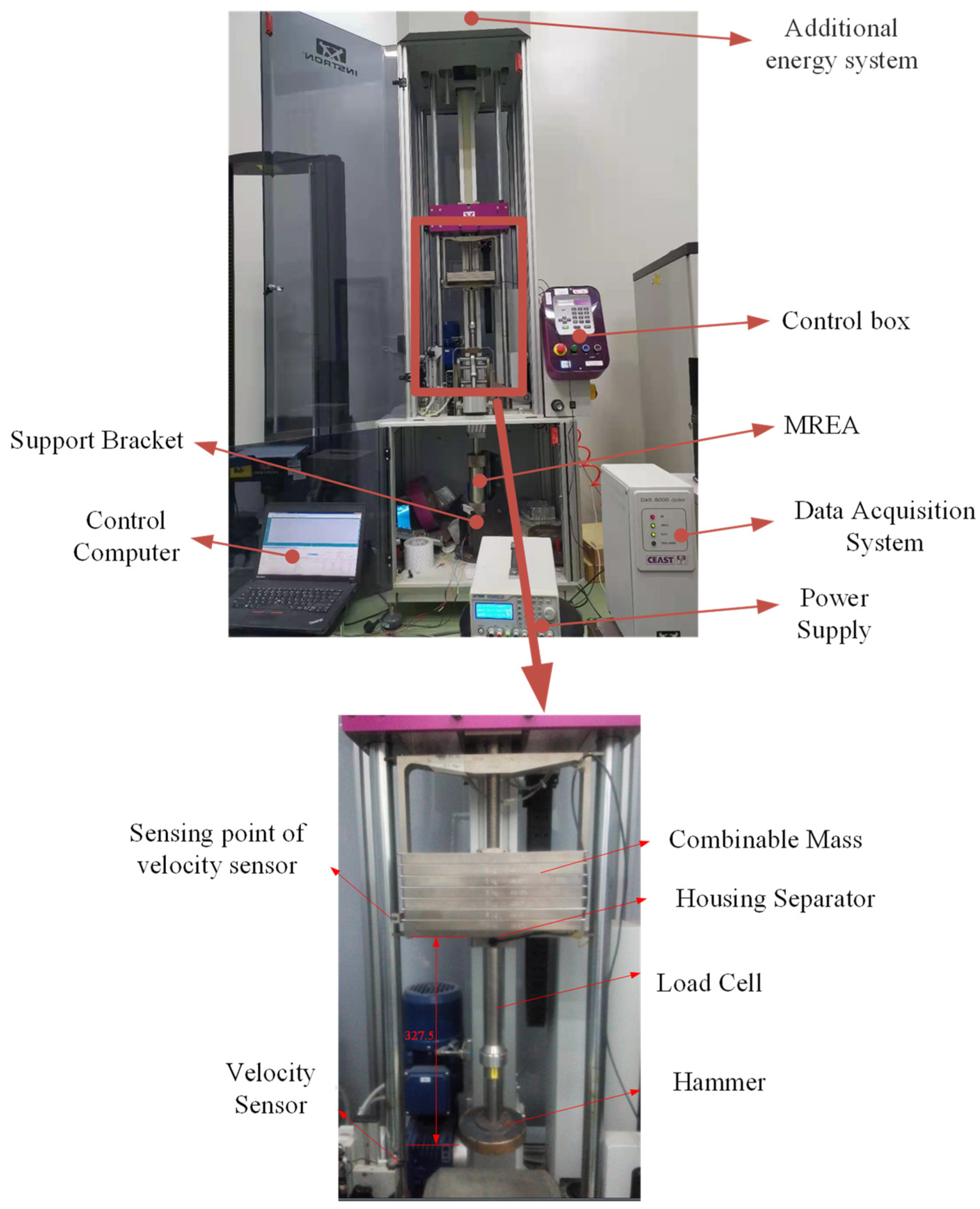
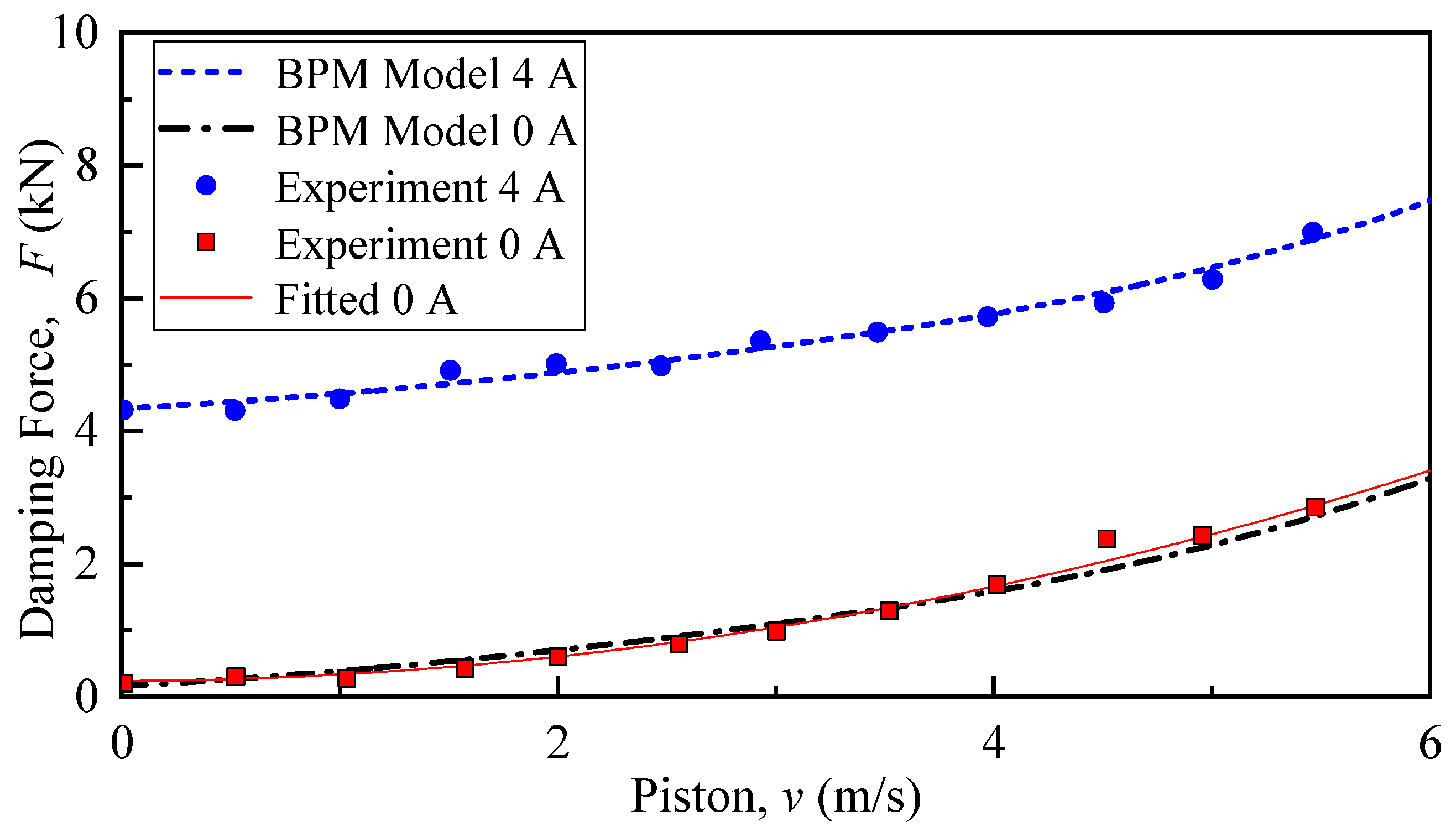

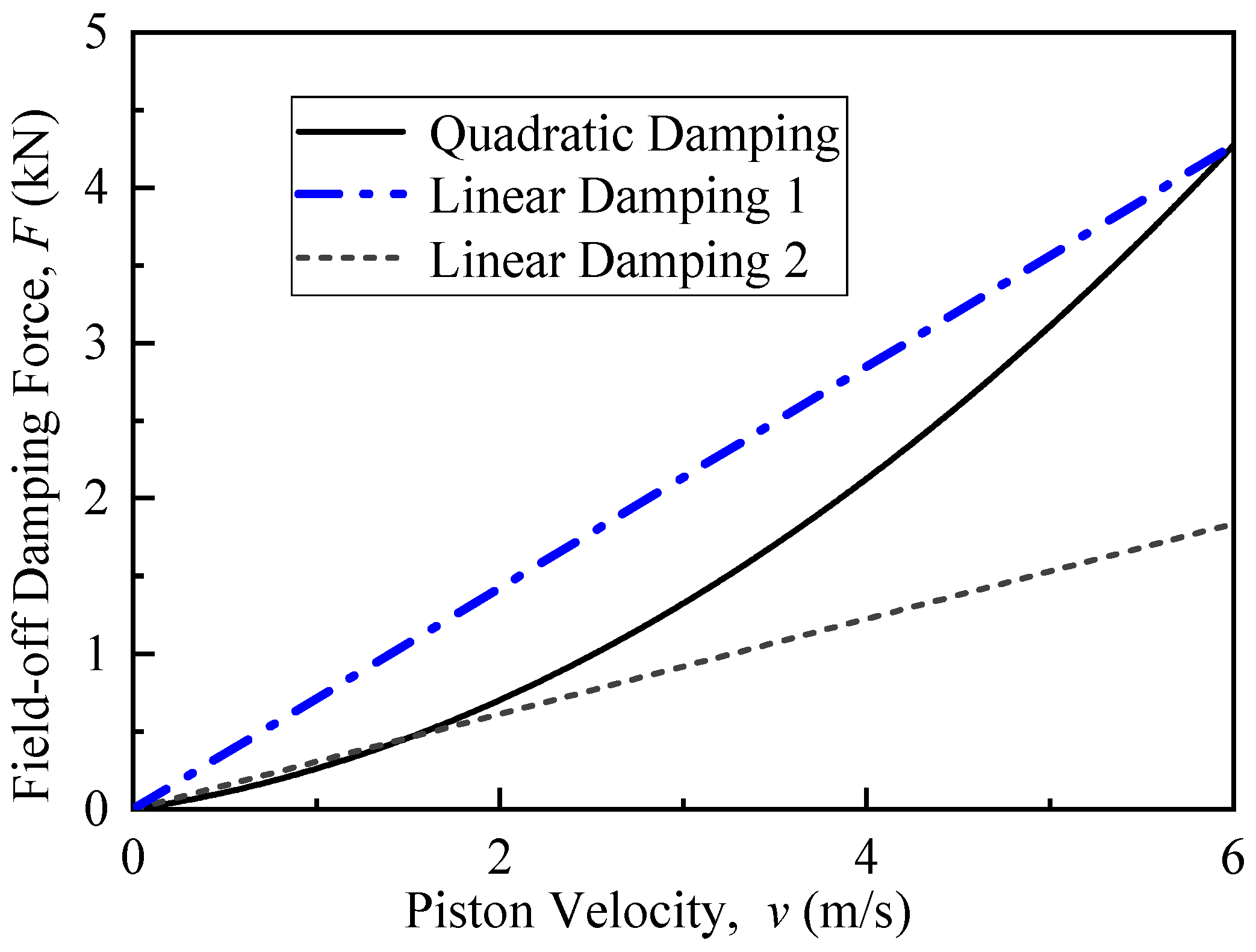
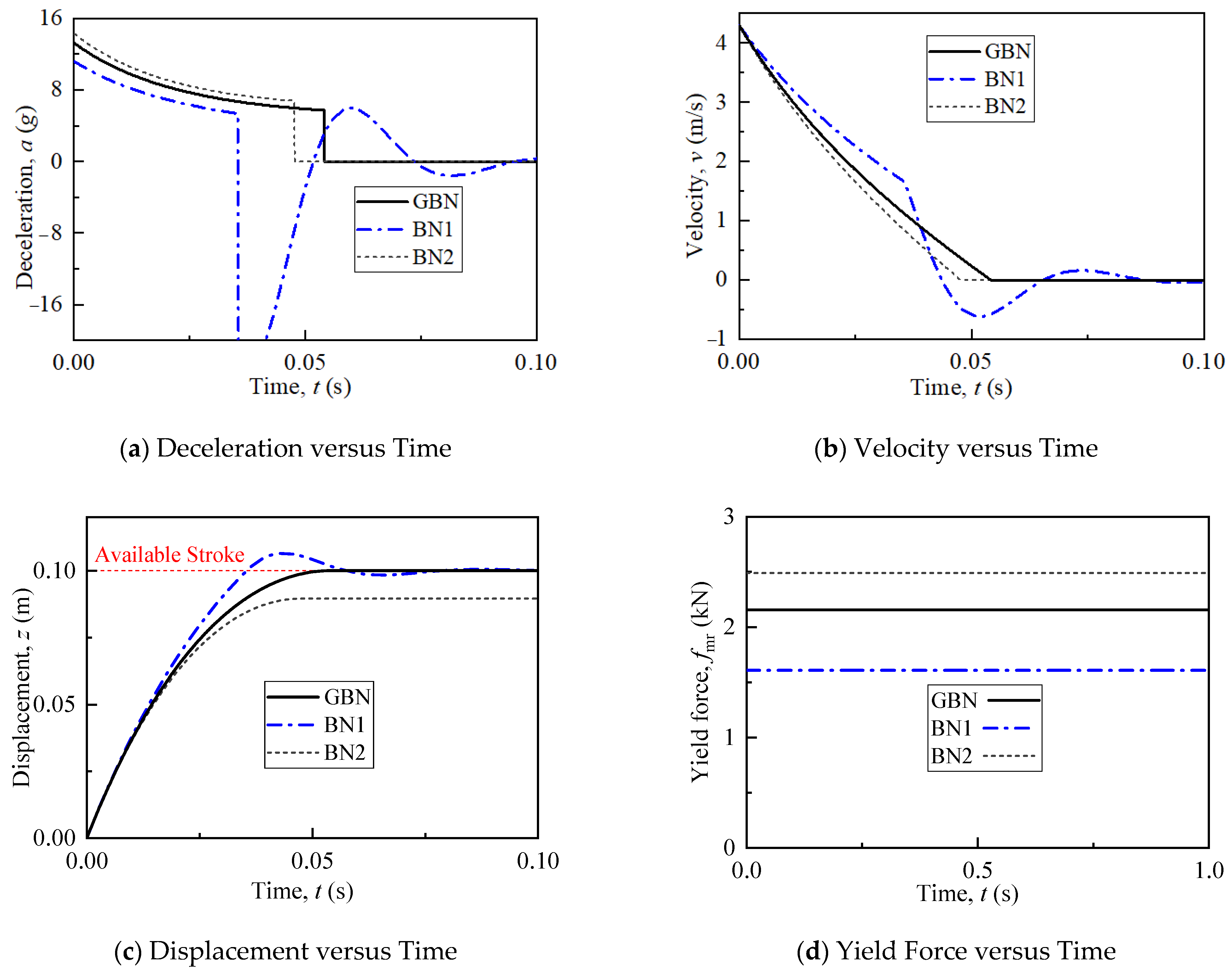
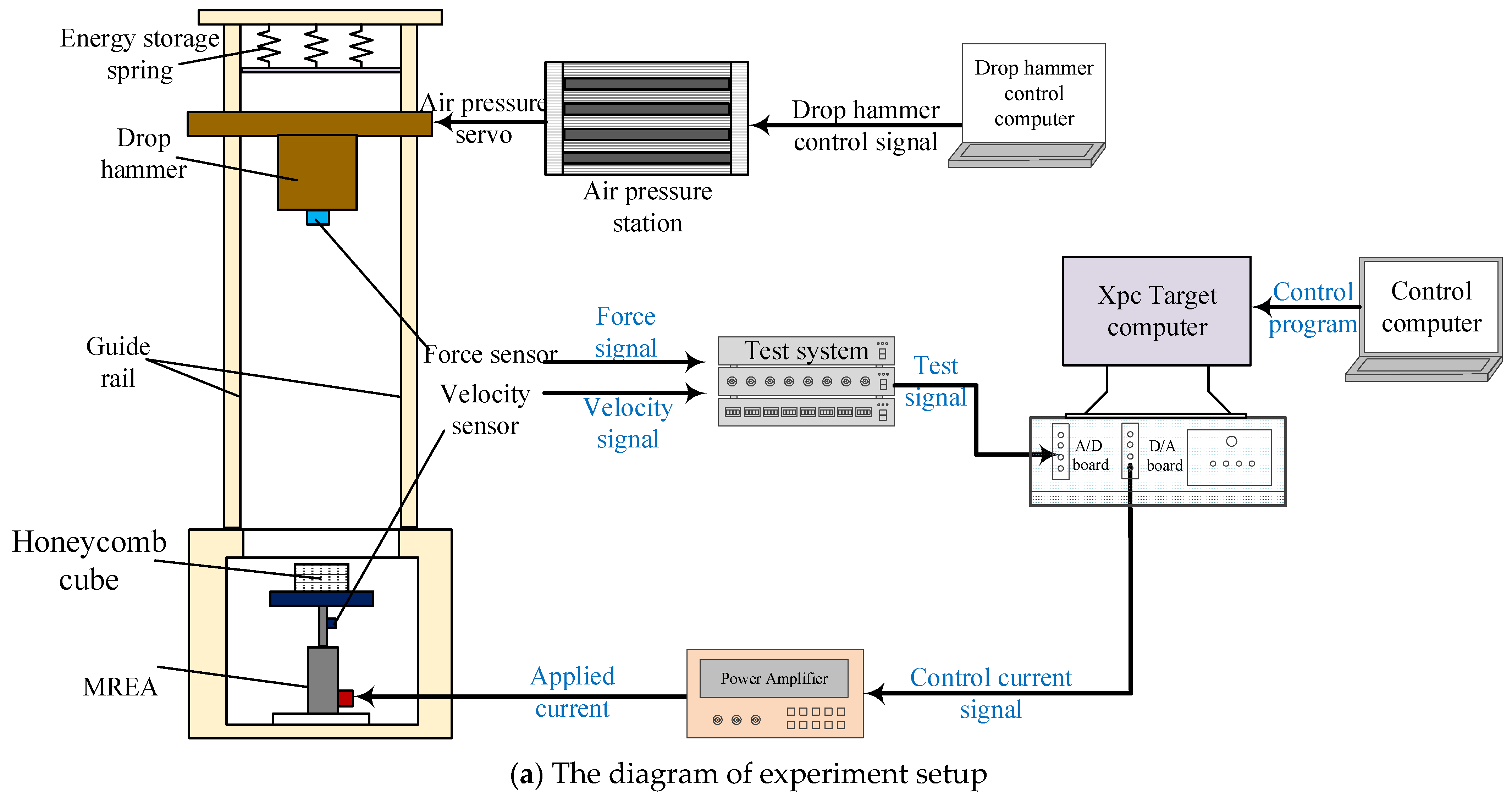


| Parameter | Symbol | Value |
|---|---|---|
| Diameter of the cylinder (m) | Dp | 63 × 10−3 |
| Diameter of piston (m) | Din | 49 × 10−3 |
| Diameter of piston rod (m) | Dr | 30 × 10−3 |
| Length of magnetic core (m) | La | 30 × 10−3 |
| Length of coil (m) | Lc | 30 × 10−3 |
| Thickness of gap (m) | d | 2.5 × 10−3 |
| Turns of coil winding (Turns) | N | 400 |
| Magnetic Field Intensity, H (A/m) | Magnetic Flux Density, B (T) |
|---|---|
| 164 | 0.2 |
| 245 | 0.4 |
| 365 | 0.6 |
| 545 | 0.8 |
| 813 | 1 |
| 1213 | 1.2 |
| 1809 | 1.4 |
| 2996 | 1.6 |
| Magnetic Field Intensity, H (kA/m) | Magnetic Flux Density, B (T) |
|---|---|
| 10 | 0.088 |
| 30 | 0.221 |
| 50 | 0.35 |
| 70 | 0.437 |
| 90 | 0.527 |
| 110 | 0.59 |
| 130 | 0.653 |
| 150 | 0.7 |
| 170 | 0.75 |
| 200 | 0.829 |
| 240 | 0.91 |
| 280 | 1.103 |
| 320 | 1.108 |
| Control Method | Yield Force (kN) | Control Current (A) |
|---|---|---|
| GBN | 1.994 | 1.366 |
| BN1 | 1.334 | 0.937 |
| BN2 | 2.33 | 2.33 |
Disclaimer/Publisher’s Note: The statements, opinions and data contained in all publications are solely those of the individual author(s) and contributor(s) and not of MDPI and/or the editor(s). MDPI and/or the editor(s) disclaim responsibility for any injury to people or property resulting from any ideas, methods, instructions or products referred to in the content. |
© 2024 by the authors. Licensee MDPI, Basel, Switzerland. This article is an open access article distributed under the terms and conditions of the Creative Commons Attribution (CC BY) license (https://creativecommons.org/licenses/by/4.0/).
Share and Cite
Wang, M.; Lu, D.; Xu, Y.; Guo, Y.; Li, B.; Wereley, N.M. Theoretical and Experimental Research on an Optimal Control for a Magnetorheological Shock Mitigation System. Appl. Sci. 2024, 14, 7317. https://doi.org/10.3390/app14167317
Wang M, Lu D, Xu Y, Guo Y, Li B, Wereley NM. Theoretical and Experimental Research on an Optimal Control for a Magnetorheological Shock Mitigation System. Applied Sciences. 2024; 14(16):7317. https://doi.org/10.3390/app14167317
Chicago/Turabian StyleWang, Mukai, Duhui Lu, Yeyin Xu, Yunfei Guo, Bing Li, and Norman M. Wereley. 2024. "Theoretical and Experimental Research on an Optimal Control for a Magnetorheological Shock Mitigation System" Applied Sciences 14, no. 16: 7317. https://doi.org/10.3390/app14167317
APA StyleWang, M., Lu, D., Xu, Y., Guo, Y., Li, B., & Wereley, N. M. (2024). Theoretical and Experimental Research on an Optimal Control for a Magnetorheological Shock Mitigation System. Applied Sciences, 14(16), 7317. https://doi.org/10.3390/app14167317






